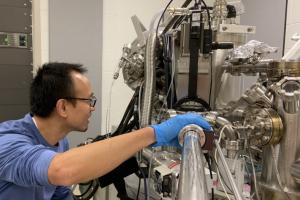Scanning X-ray Photoelectron Spectrometer (XPS)

NMCF acknowledges NSF-MRI Award #1626201 for the acquisition of this instrument.
About
Location: Jesser Hall room 148
The PHI Versaprobe III XPS instrument provides quantitative elemental and chemical analysis of material surfaces for elements with Z ≥ 3. Small-spot (9-200 micron) and large-area analyses (mm-scale) available, as well as elemental and chemical mapping. Angle-resolved XPS. In situ sample heating and cooling (150 - 850 K). Argon sputtering for removal of surface contamination or depth profiling. Adjacent UHV processing chamber and high-pressure reaction cell available for in situ deposition or processing. Samples up to 60 mm-dia. x 14 mm height.
XPS Technique Summary:
- XPS for Quantitative Elemental Composition of Surfaces (outermost <10 nm)
- XPS for Quantitative Chemical Analysis of Surfaces (outermost <10 nm)
- Elemental / Chemical Composition across interfaces with Line Scans
- Elemental / Chemical Composition across heterogenious regions with Area Maps
- Surface Specific Chemistry/Composition by Angle-Resolved XPS (~ 1nm)
- Compositional Profiles with Depth by Ion Sputtering or AR-XPS up to ~ 10µm
- Surface Kinetics from Compositional Change as a function of temperature (to 600 C)
- Technique Sensitivity:< 0.1% (atomic percentage)
- Spatial Resolution:< 10 microns
- Standard Compositional Error: ~15%
- Detection of all Elements with Z ≥ 3
Versaprobe III Features:
- Energy resolution: < 0.60 eV @ > 14kcps (10 um); < 0.90 eV @ 2.0 Mcps (100um)
- Monochromatic Al k-alpha X-rays (1486.6 eV)
- In situ Hot/Cold stage ( -140 - 600 C)
- SXI imaging for precise analysis location
- Floating Column Ar+ Ion gun (0.005 - 5.00 keV) for depth profiling and charge neutralization
- Narrow aperture for angle-resolved XPS (AR-XPS)
- Auto dual-charge neutralization
- Geometry: 45° between X-rays and spectrometer; 0-90° Sample Tilt toward/away spectrometer; Zalar rotation
- Spot sizes: 9 um – 200 um plus HP/LA (high power-large area - 100 microns x 1400 microns)
- Line scans: 9 um - 200 um x 1400 um (max)
- Compositional/Chemical Maps: typically 9 um beam scanned over 1400 um x 1400um or interpolated StageMaps over ~ 5 mm x 5mm
High-Pressure Reaction Cell Features:
Reaction studies of oxides, hydrocarbons or catalytic materials requiring a reducing environment
- Reaction cell transfer (in situ) to XPS analysis chamber through Prep Chamber; not directly coupled to XPS analysis chamber to minimize cross-contamination
- Sample heating at high pressures, temperatures to 500 ºC (dynamic mode, 2 bar max.) and 800 ºC (static mode, 1 bar max.)
- MKS Digital Mass Flow Control (100 sccm) for Oxygen or Hydrogen or other gasses
- Sample size < 10 mm x <10 mm; thickness < 3mm
- Complete vacuum pumping and gauging
- Molybdenum Mount with thermocouple
- Chamber schematics are available
Introduction to the XPS Technique:
Youtube videos describing X-ray photoelectron spectroscopy theory, instrumentation, and analysis can be found on the web, in varying detail. Links are provided here to brief descriptions of XPS fundamentals, a Khan Academy tutorial, and PHI XPS/HAXPES description of instrumentation and data.
XPS Training Videos for SmartSoft (data acquisition):
SmartSoft's queue can allow you to easily create a series of tasks to run for multiple samples on the same platen. PHI has produced several Youtube videos to help navigate the queue.
XPS Training Videos for Multipak (data analysis):
Physical Electronics Inc. has created user training videos (.mp4 format) for a wide variety of data analyses and data massaging routines in Multipak. These analyses include modules on curve fitting, quantification, analysis of depth profiles, processing of elemental and chemical maps, determining work function, etc. The videos have no sound, but brief explanatory notes on the right side of screen help to describe the action.
Contact Us
Catherine Dukes
Catherine Dukes directs the Laboratory for Astrophysics and Surface Physics (LASP) and provides expertise in X-ray photoelectron spectroscopy (XPS) for the University of Virginia's Nanoscale Materials Characterization Facility (NMCF). Her NSF and NASA funded research focuses on the interaction of radiation with surfaces.